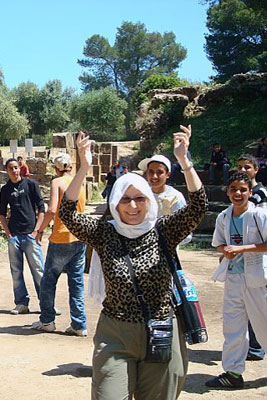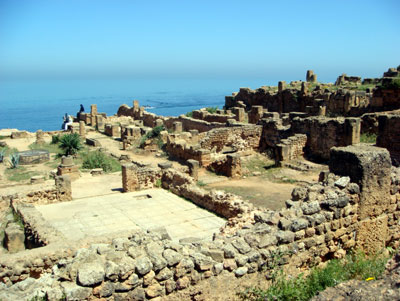An archaeological tour of Algeria
by Harriet Hughes, Alexandria, VA
In April ’08 I joined a tour operated by Spiekermann Travel (Eastpoint, MI; 800/645-3233, www.mideasttrvl.com) that focused on the archaeology of Algeria. While my friends thought Algeria to be a dangerous place, I felt very safe during my travels there. In fact, the combined toll from terrorism and crime in Algeria is significantly lower than that in the Washington, DC, area in which I live.
Ensuring safety
The Algerian government requires Europeans and North Americans to have security police escorts at all times when outside hotels, although I’m not entirely convinced that it’s purely for travelers’ safety, since Algeria is a police state and this helps fund the cost of the police force. However, the security police usually spoke English and were very friendly. Since few Algerians speak English and I don’t speak French, the police were among the locals with whom I was able to talk.
They also were very useful in a traffic jam, turning on their lights and sirens and leading us down the middle of the road between the two lanes. I felt sorry for the locals, though, knowing how annoying it is when I am forced aside for VIPs in DC.
In Algiers, we stayed at El Djazair (formerly called the St. George), a lovely hotel with large private gardens. The food was excellent but expensive (a bowl of soup cost more than $10); the desserts were scrumptious and the breakfasts, excellent. Rooms start at $300 per night.
Pleasant stops
The first day, we toured Algiers’ kasbah, a UNESCO World Heritage Site and one of the largest kasbahs in the world. Parts of it were very crowded with shops and people while other parts were residential.
La Brasserie, near the university, offered an excellent lunch and is a favorite of locals.
The next morning we flew to Ghardaïa, the heart of M’zab Valley, the location of several oasis towns listed as UNESCO World Heritage Sites. I found these very traditional towns to be full of wonderfully friendly people. Women there generally covered themselves totally, uncovering only one eye if married, two if single. Since the women needed to keep their hands covered, the men carried the purchases from the market.
In spite of satellite dishes and cell phones, the area seemed relatively old-fashioned compared to American culture, but a local man I met said that since everything is shared by the extended family, no one goes hungry. He has traveled and worked extensively in Europe and the USA but prefers the slower life and close family ties of Beni Isguen, his oasis town.
We had an excellent 3-course meal at Le Palmier. In fact, almost every meal we had on this tour was excellent.
The guest cottages at Ville dans La Palmeraie de Beni Isguen were lovely rustic cabins with adequate plumbing, and the hotel offered good food and a wonderful staff. In the evening, the staff served tea, sang and played drums for the guests by a fire under a large tent.
Temacine and Tébessa
Leaving the Ghardaïa area, we drove to Touggourt, where we had a fabulous baked lamb at Hotel Oasis before continuing on to the fortress town of Temacine. Our next two nights were spent at Hôtel du Souf in El Oued.
There we encountered a plumbing problem no one in our well-traveled group had ever seen: only boiling-hot water, no cold. When we flushed the toilet, the tank would refill with boiling water from a hot spring. To get water at a temperature that one could use to bathe required filling the tub and letting it cool overnight.
Most hotels in Algeria are government owned; nevertheless, attitudes varied from great to bad. The government runs competitions between hotels with cash bonuses for the winners. At Hôtel du Souf the staff had bad attitudes — à la Soviet Intourist circa 1988. Temacine was worth seeing, but I’d recommend finding another hotel if you go.
We moved on to Tébessa, a very interesting town with various archaeological sites within the modern city. Sorting out the Roman from Byzantine elements would have been impossible without our guide, Kader ben Salah, and our lecturer, Mohamed Halouani.
Kader is an Algerian mosaic restorer and a professor, whose English improved over his two weeks with us. Mohamed, fluent in English, is a French-trained Tunisian linguist and historian whose interests focus on North African history and archaeology. Both were excellent and each one’s knowledge complemented the other’s.
In Tébessa we had a chance to walk through local markets. Most of the time, prices were marked on goods and bargaining was either impossible or done only when buying large quantities. There was a unique absence of souvenirs, except for a few made-in-China souvenirs for the local population.
Roman ruins
In Annaba, we went to the Hippo Regius, the center of Saint Augustine’s ministry, and to a modern French church that has a relic of Saint Augustine.
The Roman ruins of Timgad were a highlight and Lambaesa was interesting. Timgad’s Temple of Minerva has been sufficiently restored and now serves as a museum. The baptistery in the basilica is very well preserved.
The third-century-BC tomb of Medracen was worth a look, but no one is really sure who’s buried there.
North of Constantine, Tiddis was a very interesting Roman military outpost built on a mountainside. The water cisterns were quite impressive and the view of the countryside was worth the climb.
A photographer’s delight, Djémila generally is considered the most outstanding Roman site in Algeria, and it certainly lived up to its billing. In addition to spending several hours walking around the site, we saw wonderful mosaics there in the museum, which is not always open to the public. Touring Algeria without a guide who is sufficiently connected to get into the various sites and museums would be a waste of time.
Officially, photographing the sites is not permitted; however, if you include people in your photo, you are usually permitted to photograph the site. It wouldn’t be so annoying if they sold postcards or books with pictures of the sites, but they don’t.
Tipaza was full of local tourists and we met a lot of local teens. We danced with some of the kids to their modern music and had our pictures taken by them. We were a big attraction.
In fact, most Algerians were very excited to find that American travelers had come to their country. Even hotel staff seemed amazed. They get European tourists, although not in large numbers, but Americans are uncommon. Because tourism is not a big industry in Algeria, the majority of the people with whom we came in contact were very welcoming.
The tourism infrastructure (choice of hotels and the availability of postcards, souvenirs, information on sites and signage at the sites) is limited, but the roads generally are excellent. Because automobile ownership is growing, rush-hour traffic is common but not as bad as at home.
Internet access is readily available for about $1 per hour in Internet cafés, but it’s expensive in hotels, when available.
The cost for our 2-week tour, including air from New York City and all but one meal, was $5,875 per person, double. With Algeria’s economy tied to the euro, I expect it will cost more in the future. I do recommend a visit to Algeria, and now, with the number of visitors still limited, is a great time.
If you have questions, contact me by e-mail c/o ITN.





